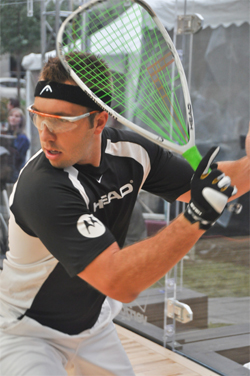|
|

Dealing with String Stress From New Racquet Designs: A Manufacturer's Challenge
By Steve Crandall
Vice President, Sales & Marketing
Ashaway Racket Strings

As racquet manufacturers have attempted to increase power by lengthening strings through different head shapes, stringing patterns, and racquet designs, they have inadvertently increased the need for higher stringing tensions, and exposed strings to much greater premature breakage due to off center hits. |
No one can accuse racquet designers of sitting on their hands these past few years. Indeed, so frequent are the "breakthroughs," "revolutions," and "new technologies" routinely announced in their ads that it's often difficult to keep them straight, or understand fully what they do. (This, of course, never happens with string!) Just look at some of the more recent pronouncements:
- "Hi-Octane Boosters" that add power, solidify the string bed, and improve control
- "Flexible Tubes" inside the handle that increase ball control, decrease vibration, and enhance string life
- "Power Rings" that enhance control of strings and change the balance point of your racquet
- "Power Holes" that increase striking power by "the strategic reinforcement of select cross strings."
However, as a string manufacturer, I do have concern with the additional stress on the string bed caused by some of these innovations. For example, as racquet manufacturers have attempted to increase power by lengthening strings through different head shapes, stringing patterns, and racquet designs, they have inadvertently increased the need for higher stringing tensions and exposed strings to much greater premature breakage due to off center hits. Another side effect of longer strings and higher tensions is increased tension loss and more "trampoline effect" than is desirable for the majority of players.
Therefore, when you combine these longer strings with more open-faced stringing patterns, the incidence of catastrophic string breakage at the frame by power players (between 10 o'clock and 2 o'clock especially) increases significantly. The root cause of this phenomenon is the combination of reducing the number of strings in contact with the ball at stress points and the higher stringing tension required to achieve an acceptable balance of control and power from the racquet/string combination.
Another area of concern is the evolution of grommets/stringing systems over the last decade (e.g., both the grommets in the frame and the string tubes through the racquet handle). These innovations have generally mandated the use of thicker and stronger strings to achieve adequate string life. Thicker strong strings help to address the string breakage problem, but often at the expense of playability and overall string performance.
So what's a manufacturer to do? Our job is to make strings people want to use, not tell them they have to use strings they don't want. If these new racquet designs improve performance, we need to make strings that perform as well as they do. We've had some success beefing up the jackets, or wear layers, on our strings, and with changing the core construction packages. But the one solution we've found more effective than any other was one we actually happened on by accident: transferring the use of PEEK polymers from the central core to the wear layer.
PEEK polymers like Zyex® have a number of properties that lend themselves to racquet string, including exceptional elasticity, or dynamic stiffness, which increases power and absorbs impact shock; the ability to hold tension, which increases the playing life of string; low coefficient of friction, which increases the ability to generate spin; and more. But another key attribute of PEEK is its abrasion resistance. In tests measuring "thread on thread" abrasion conducted at room temperature, PEEK multifilaments outlasted aramid fibers by a factor of approximately 5.5. In fact, one of the original applications for PEEK was as aerospace insulation designed to protect electrical wiring from abrasion damage.
We had been thinking of abrasion resistance in terms of string on string wear, but the increased string stress caused by these new racquet designs clicked on the light bulb in our heads. If Zyex insulation could protect wire, we thought, why not string? So we got to tinkering in the lab and what we've come up with is an entirely new surface element of Zyex filaments in the jacket of the string that increases their overall durability in these new racquets, and especially enhances loop strength to reduce frame breakage. Being made of Zyex, it also optimizes power and improves tension holding. In short, an excellent way to make string for newer designed racquetball racquets. (Zyex is a trademark of Zyex Ltd)
|